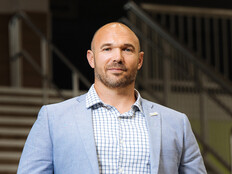A 21st Century Classroom Makeover
For veteran teacher Frances Mikasa, the most significant difference she's seen since Tulare City School District (TCSD) equipped her classroom with 21st century tools hasn't been the hardware or software itself.
"The technology is amazing – especially the way we can tailor it to our lessons and incorporate elements such as video," says Mikasa, who teaches seventh-grade science at Live Oak Middle School, one of 14 schools in the central California district. "But the way it gets the students engaged, that's the big thing. These are middle school kids, but they raise their hands like crazy for a chance to go up to the interactive whiteboard."
Although Tulare has a population of roughly 60,000 people and is located nowhere near an urban center, its new state-of-the-art public library reflects city leaders' commitment to technological progress and advanced learning techniques. The leaders of Tulare City School District are no different. "Enriching the curriculum and giving our teachers and kids more is always the focus," says Michael Milanesi, TCSD's curriculum specialist.
To that end, TCSD has been forging ahead with an ambitious technology transformation that's designed to enhance learning for its roughly 9,500 pre-K-8 students. The district's efforts to build a 21st century classroom experience crystallized in early 2009, when Milanesi and several district colleagues attended a conference for educators who use technology in the classroom. They left the conference intrigued by the possibilities of interactive learning systems, particularly those offered by Promethean.
Daryl Shelton, TCSD's director of information services, and other administrators had already held many discussions about the need to support more presentation-based teaching in district classrooms – especially in the four middle schools.
So Superintendent Luis Castellanoz tasked IT staff with implementing such tools in at least one classroom at each of the district's schools. "We wanted to do more," Shelton says, "but it was already a huge financial commitment, and we thought we would have to move slowly."
That spring, Shelton and Milanesi invited a variety of manufacturers to demonstrate their products and also solicited feedback from both administrators and teachers about their specific concerns. All signs pointed to Promethean as the solutions provider that could best meet the district's needs, Shelton says. But cost was a substantial hurdle, with initial estimates for a full Promethean system averaging $7,500 per classroom.
There also was a growing consensus among school officials that the technology should be made available to as many classrooms as possible as quickly as possible. "As we got into planning and looking at costs and the different ways to provide the technology, we were always thinking about how we could expand upon this in the foreseeable future," Shelton says.
Friends and Neighbors
Help arrived in the form of American Recovery and Reinvestment Act grants and via partnerships with CDW•G and ACT Computer Services, a consulting company in nearby Fresno, Calif., that was brought in to assist with the deployment.
"The ARRA funds really made it possible for us to expand and implement the project," Shelton says. "We went pretty quickly from looking at one complete Promethean solution at each school site to looking at a bunch of classrooms at a variety of sites. But we still needed some help to do that."
CDW•G facilitated negotiations throughout the technology selection process to ensure that the district received the best possible price on each of the tools that would transform its classrooms into 21st century learning environments. In some cases, district officials substituted or delayed their purchase of certain components to ensure overall functionality at a lower cost.
In the end, ACT delivered a custom implementation at a cost of about $2,200 per classroom. "The key to our being able to do this at an affordable cost has been accommodation from all sides – from the district, from CDW and from ACT," Shelton says. "It's really been a team effort for us to be able to accomplish a project this large."
The initial deployment, completed during the 2009-2010 school year, outfitted about 270 second- through eighth-grade classrooms throughout the district (as well as 23 special-education and bilingual classrooms) with Epson PowerLite 410W multimedia short-throw projectors, Promethean ActivInspire software and ActivSlate graphics tablets.
At first, all teachers used the new equipment with conventional whiteboards due to the cost concerns. But over time, the district has replaced those boards with Promethean's ActivBoard 100 and 300 Pro interactive whiteboards. District officials are now installing the new boards in all middle school classrooms and have even begun adding the boards to some of the fifth- and sixth-grade classrooms.
"We're working our way down the grade levels with the interactive boards that directly control the computers," Shelton says. "In the interim, we've used the ActivSlate, which controls the computers and lets teachers highlight or circle information or write annotations as information is presented."
Teaching the Teachers
As the initial deployment was getting under way, TCSD's IT team solicited applications from tech-savvy teachers who were interested in piloting the 21st century classrooms. Fourteen teachers spent summer 2009 going through a training program, led by Milanesi, which included presentations from Promethean support personnel and hands-on learning activities. Once the school year began, these teachers continued to meet with Milanesi each month to discuss how to use the technology to support the curriculum.
"They were a really energized group to begin with, and then they got lots of support on how to use the software – not just as technology, but as a new way to present content," Milanesi says. "These 14 people had a head start and some expertise, and then when the district went full-bore in expanding the tools to other classrooms and other schools, they were incredibly helpful to the other teachers at their sites."
Although some teachers were hesitant about the technology at first, buy-in spread quickly. "Just like the students, teachers are invigorated by something new," says Live Oak Middle School's Mikasa, who participated in the summer 2009 training program. "One of the reasons we are teachers is that we're interested in learning and finding better ways to do things."
That acceptance had more to do with real pedagogical benefits, Mikasa continues, and wasn't just about getting used to the technology. In particular, she believes ActivInspire's "flipcharts," which help to organize and highlight content, make her a more efficient teacher. "With the software and the presentation technology, the lesson is seamless," she says. "I can add more elements without interruptions and without switching gears."
School administrators are equally impressed by the 21st century classrooms' power to help teachers present information in ways that students will more readily understand. "The technology provides a 'wow' factor for sure, but the kids are so technology-based that you see them more focused and more on task with the new equipment," says Gary Yentes, principal of Los Tules Middle School. "Participation is up, especially when teachers hand off the slates and let the kids take control. They become very proficient very quickly."
Teacher training, continuing support and the speed with which problems have been solved have all contributed to the project's success to date, Yentes adds. "There have been a few bumps, but no lingering issues," he says. "I've been impressed by how effectively the teachers have used the technology."
From Passive to Active
In the months ahead, the district will continue installing ActivBoards and will bring ActivExpression student response systems to more classrooms. (Mikasa says the clickers were initially distributed only to science classrooms.)
Although some standardized test scores have gone up in the two years since the district's 21st century classroom transformation began, both Mikasa and Milanesi warn that it's too soon to responsibly attribute those results to the use of these technologies. For now, Milanesi says, teacher feedback offers the clearest measure of the project's success.
"There were teachers who originally said, 'How am I going to use this stuff?'" he explains. "Now, they're telling us they don't know how they survived without it."
Listen and Plan
It's not easy to pull off a large and complex project like the 21st century classroom initiative undertaken by California's Tulare City School District. Every aspect of the process – identifying needs, finding and implementing the right technologies, and training teachers – requires detailed planning and ongoing attention. Director of Information Services Daryl Shelton and Curriculum Specialist Michael Milanesi offer this advice based on their experience overseeing TCSD's deployment.
- Have a detailed plan for installation, implementation and training.
- Think about your existing technology, as well as your choice of new technology. For instance, classroom computers will have to be able to run whatever interactive software you select.
- Make sure that IT staff and curriculum development staff collaborate regularly.
- Listen to teachers every step of the way, from finding out what they need from the technology during the selection process to how the software and hardware are working in their classrooms to support lessons.
- Consider professional development and ongoing technical support to be essential components of your deployment.
- Fix minor sticking points such as burned-out bulbs and lost tablet styluses quickly so that small frustrations don't morph into an overall disillusionment with the technology.
68% of teachers consider interactive whiteboards a valuable classroom technology.
SOURCE: "Deepening Connections: Teachers Increasingly Rely on Media and Technology" (PBS and Grunwald Associates, 2010)







